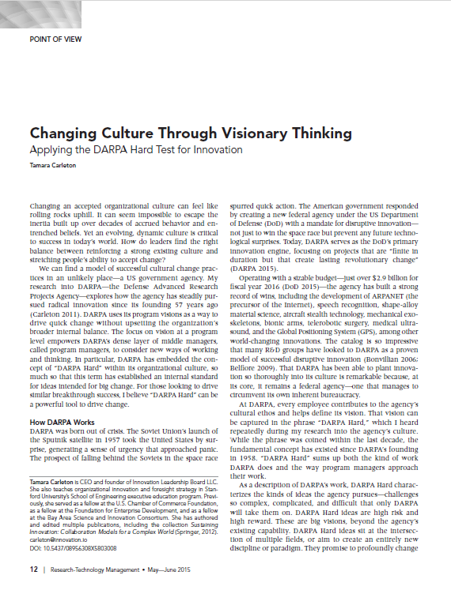My writing delves into how mavericks, innovators, and leaders from Global 1000 organizations to government agencies build innovative futures.
I invite you to browse my writing selection below…
Popular Books
Building Moonshots: 50+ Ways to Turn Radical Ideas into Reality
Written by Tamara Carleton and William Cockayne, Building Moonshots is your handbook for the almost impossible, describing over fifty ways for building big ideas with big impact. Financial Times describes this book as “easily digestible” with “practical insights for extraordinary entrepreneurship”.
Playbook for Strategic Foresight and Innovation
This playbook shows you how to use an integrated set of 15 original methods, including step-by-step instructions and illustrated examples, for bridging from strategic foresight to innovation. Created at Stanford University and tested worldwide, these tools have been used by hundreds of teams globally. The playbook is also available as a free PDF from www.innovation.io/playbook.
Futures Literacy Laboratory Playbook: An Essentials Guide for Co-Designing a Lab to Explore How and Why We Anticipate
Edited by Tamara Carleton and Riel Miller and designed by Arman Amin, this guide combines all setup material in one place to run a UNESCO Futures Literacy Laboratory in your own community. Content includes sample lab agendas, activity examples, planning tips, facilitator scripts, and more. UNESCO has run over 115 of these labs with its global network.
ME310 at Stanford University: 50 Years of Redesign (1967-2017)
Edited by Tamara Carleton, this commemorative book features 70 contributors describing their memories and experiences with an award-winning, engineering design course called ME310, which has been taught at Stanford University since 1967.
Scholarly Materials
Edited collections
Inventing the Almost Impossible: Creating, Teaching, Funding, and Leading Radical Innovation
Whether you're seeking to invent the seemingly impossible or solve problems for which no market exists yet, this collection of essays renews the research agenda for the deliberate study of invention. Through critical analysis, industry case studies, and teaching examples, an international and interdisciplinary group of scholars, practitioners, and mavericks offer practical advice for bringing visionary development to life.
Sustaining Innovation: Collaboration Models for a Complex World
Featuring contributions from leading researchers, business leaders, and policymakers representing North America, Europe, India, Africa, and Australasia, this volume investigates different combinations of collaborative arrangements among innovation actors, many of which are changing conventional expectations of institutional relationships. Several authors expand on our understanding of the triple helix model, positing an emerging quadruple helix (encompassing business, academic, government, and civil society) as the new standard, while other authors address aspects of open innovation, co-creation, and user-centered design as alternative models of collaboration.
Key Works on DARPA (and similar government agencies)
“Inspired by DARPA: A global comparison of radical innovation government agencies” in Inventing the Almost Impossible (2023)
The Defense Advanced Research Projects Agency (DARPA) in the United States is renowned for its success in funding radical innovation. This chapter provides an overview of various government agencies that have adopted the core DARPA model outside the defense space in a wide spectrum of areas, such as for homeland security (HSARPA), intelligence (IARPA), energy (ARPA-E), health (ARPA-H), and climate (ARPA-C) in the United States, as well as several other notable examples in Europe and Asia, such as JEDI and ARIA. The chapter compares these groups to the DARPA model and identifies key differences that can offer lessons to others seeking similar outcomes. The chapter also notes the existence of other agencies that were missed due to time constraints, so that a deeper analysis may continue of government agencies around the world pursuing radical innovation.
“The value of vision in radical technological innovation” in The DARPA Model for Transformative Technologies (2020)
Chapter 5, by Tamara Carleton, discusses the central role of technical vision in DARPA’s operations and results. Overall, this book entitled The DARPA Model for Transformative Technologies: Perspectives on the U.S. Defense Advanced Research Projects Agency is a remarkable collection of leading academic research on DARPA from a wide range of perspectives, combining to chart an important story from the agency’s founding in the wake of Sputnik to the current attempts to adapt it to use by other federal agencies. Informative and insightful, this guide is essential reading for political and policy leaders, as well as researchers and students interested in understanding the success of this agency and the lessons it offers to others.
“Changing culture through visionary thinking: Applying the DARPA Hard Test for innovation“ in Research-Technology Management journal (2015)
US government agency DARPA has embedded the concept of “DARPA Hard” within its organizational culture, so much so that this term has established an internal standard for ideas intended for big change. For those looking to drive similar breakthrough success, I believe “DARPA Hard” can be a powerful tool to drive change. Based on this concept, I introduce a DARPA Hard Test that assesses an idea across the four dimensions of DARPA Hard: far-reaching, technically challenging, multidisciplinary, and actionable. DARPA has had over 50 years to build a culture that nurtures disruptive change. The DARPA Hard Test can help any type of organization consider what it is doing—and what it might do differently—to create such an innovation culture for itself.
Other Resources
MOVE Workshop Facilitation Handbook
The MOVE framework is designed to help you plan an effective team workshop to address innovation capabilities within your group or company. MOVE is an acronym based on four dimensions of team innovation: Make, Observe, Visualize, and Engage. The handbook was funded by Sweden’s Institute for Management of Innovation and Technology (IMIT) and the Product Innovation Engineering Program (PIEp).










